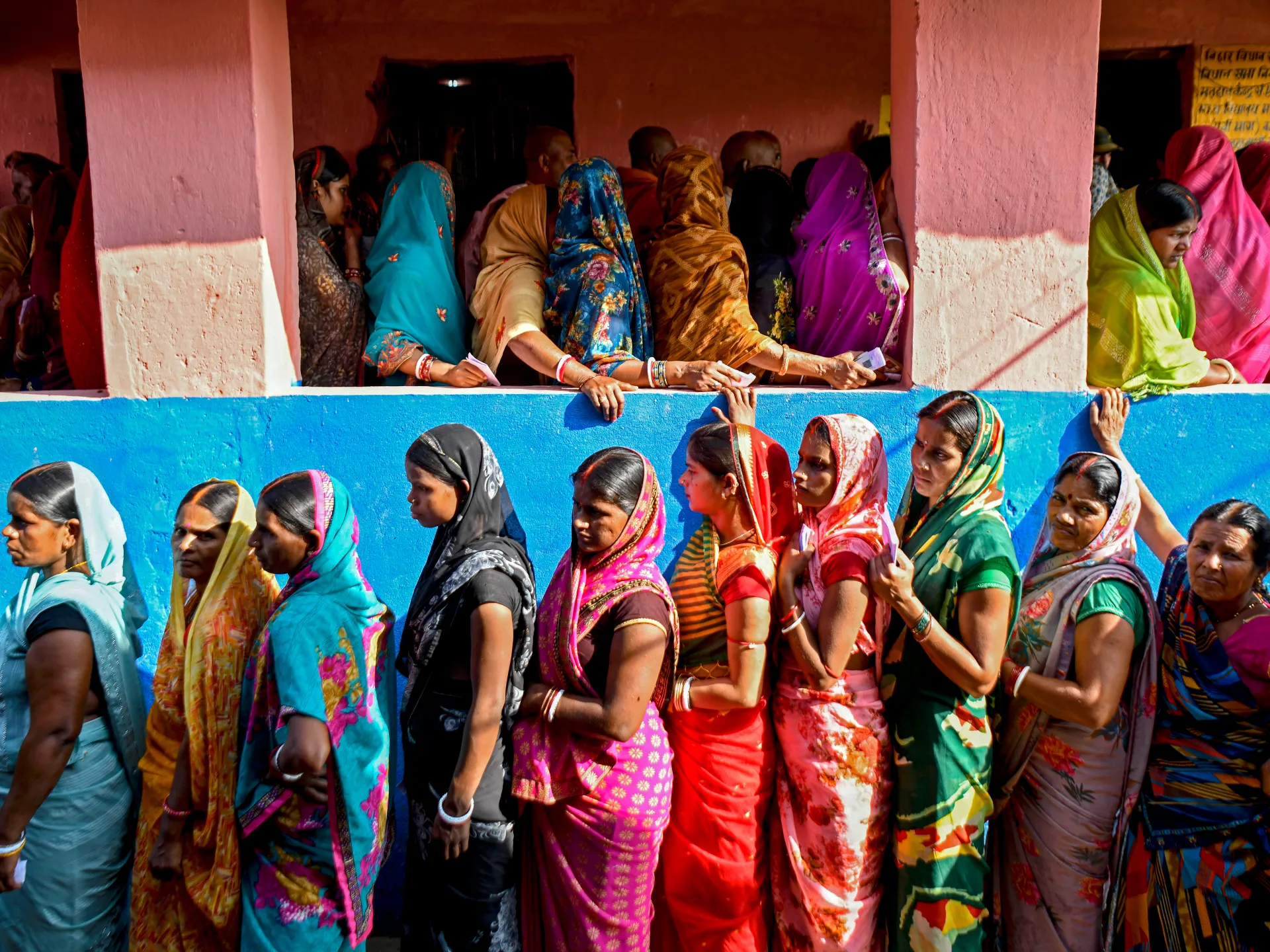The National Democratic Alliance (NDA), led by Indian Prime Minister Narendra Modi’s Bharatiya Janata Party (BJP), is heading for a sweep in the legislative assembly elections in the eastern state of Bihar.
The election in India’s third-most populous state, with 74 million registered voters across 243 assembly constituencies, has been viewed as a key test of Modi’s popularity, especially among Gen Z: Bihar is India’s youngest state.
Recommended Stories
list of 3 itemsend of list
Vote counting concluded on Friday after two phases of voting on November 6 and November 11.
Here is more about the election results and what they mean.
What was the result of the Bihar election?
As of 5:30pm (1200 GMT) on Friday, the NDA had won two seats and was leading in 204 out of 243, while the opposition Mahagathabandhan, or the Grand Alliance, with the Indian National Congress and the regional Rashtriya Janata Dal (RJD) as the main parties, was leading in just 33 seats, according to the Election Commission of India (ECI).
The Bahujan Samaj Party (BSP), which is currently not part of either alliance, was leading in one seat. The All India Majlis-E-Ittehadul Muslimeen (AIMIM), another party that does not belong in either major alliance, had won or was leading in the remaining five seats.
BJP and allies
- Within the NDA, the BJP had won or was leading in 93 seats with a 20.5 percent overall vote share.
- The regional Janata Dal (United) or JD(U), a key NDA constituent, had won or was leading in 83 seats, with 19 percent votes overall.
- Another local NDA ally, the Lok Janshakti Party (Ram Vilas) or LJPRV, had won or was ahead in 19 seats.
- The Rashtriya Lok Morcha (RSHTLKM) was leading in four seats.
- The Hindustani Awam Morcha (Secular), or HAMS, had won or was leading in five seats.
Opposition alliance
- The Congress, India’s main opposition party, had won or was leading in five seats with 8.7 percent of the overall vote.
- The Grand Alliance’s biggest party, RJD, had or was leading in 26 seats with 22.8 percent of the vote.
- The Communist Party of India (Marxist-Leninist) (Liberation), or CPI(ML)(L), was leading in one seat.
- The Communist Party of India (Marxist), or CPI(M), was ahead in one seat.
How are Tejashwi Yadav and Maithili Thakur doing?
As votes were being counted, two of the most watched constituencies were Raghopur and Alinagar.
Raghopur has long been an RJD stronghold. But for some time during counting, Tejashwi Yadav, the son of RJD leader Lalu Prasad Yadav and the party’s de facto chief now, was trailing behind BJP candidate Satish Kumar in the Yadav family bastion. This had switched to a 13,000 vote lead for Yadav by 1200 GMT, with most votes counted. If Yadav were to still lose, it will be a historic defeat for what was, many years, the first family of Bihar. He previously won the seat in 2015 and 2020. His father has also won from Raghopur twice in the past, while his mother, Rabri Devi, has won it three times.
Popular folk singer, Maithili Thakur, representing the BJP, was leading in the Alinagar seat, with the RJD’s Binod Mishra trailing by 8,588 votes — another close contest.
What is driving the results?
Female voters
Political analysts attribute the gains for the key governing party in this election to the appeals Modi’s party has made to female voters.
In September, the BJP transferred about $880m to 7.5 million women – with 10,000 rupees ($112.70) paid directly into their bank accounts – under a seed investment programme called the Chief Minister’s Women Employment Scheme. Modi’s office said: “The assistance can be utilised in areas of the choice of the beneficiary, including agriculture, animal husbandry, handicrafts, tailoring, weaving, and other small-scale enterprises.”
Women make up nearly half of all eligible voters in Bihar, where women’s political participation is on the rise. Female representation in the state has historically been low. But in 2006, Bihar reserved 50 percent of seats on local bodies for women, which has boosted their political representation.
Female voter turnout in the state has often surpassed that of men since 2010. The turnout among women this time was 71.6 percent, compared with 62.8 percent for men.
Voter ID checks
The opposition has also accused the ECI of deliberately revising the official voter list to benefit the BJP via a Special Intensive Revision (SIR) of the electoral rolls over the past few months. Registered voters were required to present documents proving they were Indian nationals and legal residents of the constituency in which they voted.
As Al Jazeera reported in July, however, many of the poorest people in Bihar do not hold any of the several documents that the ECI listed as proof of identity.
The opposition argues, therefore, that this new requirement could disenfranchise poor and vulnerable groups, including disadvantaged castes and Muslims, who typically vote for the RJD-Congress alliance.
In September, the ECI removed 4.7 million names from Bihar’s rolls, leaving 74.2 million voters. In Seemanchal, a Muslim-majority area, voter removals exceeded the state average.
What is the significance of these results?
Bihar is India’s third most populous state, home to 130 million people. It sends the fifth-highest number of legislators to parliament.
The latest vote has been viewed as a key popularity test for Modi, who was sworn in for his third premiership after he won the national elections in June 2024.
But the BJP failed to secure a majority in the national election on its own, forcing it to rely on regional allies such as the JD(U) to form the government.
Since the national election, the BJP has won most major state elections, and the streak seems to be continuing in Bihar.
